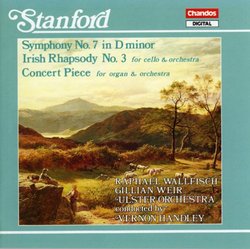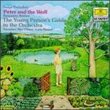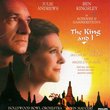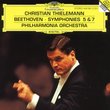| All Artists: Charles Villiers Stanford, Vernon Handley, Ulster Orchestra, Gillian Weir Title: Symphony No. 7/Irish Rhapsody No. 3 Members Wishing: 0 Total Copies: 0 Label: Chandos Release Date: 10/28/1992 Genre: Classical Styles: Forms & Genres, Concertos, Historical Periods, Romantic (c.1820-1910), Symphonies Number of Discs: 1 SwapaCD Credits: 1 UPC: 095115886120 |
Search - Charles Villiers Stanford, Vernon Handley, Ulster Orchestra :: Symphony No. 7/Irish Rhapsody No. 3
 | Charles Villiers Stanford, Vernon Handley, Ulster Orchestra Symphony No. 7/Irish Rhapsody No. 3 Genre: Classical
You can hear the German Romantic backbone of Stanford's music, particularly Brahms, in his Symphony No. 7. But Stanford doesn't merely ape the Germans; he brings his own rich tunefulness from years of gathering Irish, En... more » |
Larger Image |
CD DetailsSynopsis
Amazon.com You can hear the German Romantic backbone of Stanford's music, particularly Brahms, in his Symphony No. 7. But Stanford doesn't merely ape the Germans; he brings his own rich tunefulness from years of gathering Irish, English, and Welsh folk songs. What you end up with is very robust English Romanticism, the kind that will launch Vaughan Williams, Elgar, Walton, and a patch of others. The Irish Rhapsody 3 is for cello and orchestra and is based on two Irish folk songs. The disc concludes with the Concert Piece for Organ and Orchestra, a rousing crowd- pleaser. Chandos has produced a great series. --Paul Cook Similar CDs
Similarly Requested CDs |
CD ReviewsEnjoyable late romantic symphony R. Broadhead | Southwestern USA | 11/12/2006 (5 out of 5 stars) "This was the last of Stanford's 7 symphonies. It was written in 1911 and first performed in 1912. It was written for the centenary of the London Philharmonic Society. At a length of just 28:28 this was short for symphonies of its day. However, it is a delightful work, full of British musical idioms as well as a majestic quality suitable for early 20th century England. It calls for a relatively small orchestra of strings, two winds, four horns, two trumpets, three trombones, and drums. In places reminiscent of Brahms, Dvorak and perhaps even a little Saint Saens (the opening theme), this composition is nonetheless strikingly original. It is a quite enjoyable if obscure treasure, without a trace of the dissonance or discord that so often had crept into music by the time it was written. This symphony has more in common with the late 19th century than with the early 20th century.
The Irish Rhapsody No. 3 was written in 1913 and is based on the Irish melodies The Fairy Queen (absolutely beautiful), The Munster Cloak, and The Black Rogue. Although the melodies are not original, Stanford's orchestration is masterful and the extended parts for solo cello bring out the heartfelt qualities of the Irish folk music superbly. If the liner notes are correct, it appears that this work may never have been performed publicly until the Ulster Orchestra and rafael Wallfisch (cello) took it up. Its a shame, because it is a most enjoyable light classical work that would be perfect as a companion piece in a concert by any modern orchestra. The third piece on this recording is Stanford's Concert Piece for Organ and Orchestra, written in 1921 just three years before the composer's death. It uses quite a bit of brass. The mood is majestic and the organ is at the fore often. This recording is apparently its first performance. In Stanford's day, it was rejected by a number of publishers, perhaps a victim of the changing tastes in music. The Ulster Orchestra under the direction of Vernon Handley has done an excellent job in the performances recorded on this CD. The playing is clear, direct, smooth and the different parts of the orchestra are always well coordinated. Rafael Wallfisch does a very fine job with the cello solos in the Rhapsody and Gillian Weir is superb as the soloist in the Concert Piece for Organ. The recording is bright, clear and well balanced. Chandos is to be commended for producing this excellent recording of these most enjoyable, obscure works which had been lost and buried." |

 Track Listings (6) - Disc #1
Track Listings (6) - Disc #1







